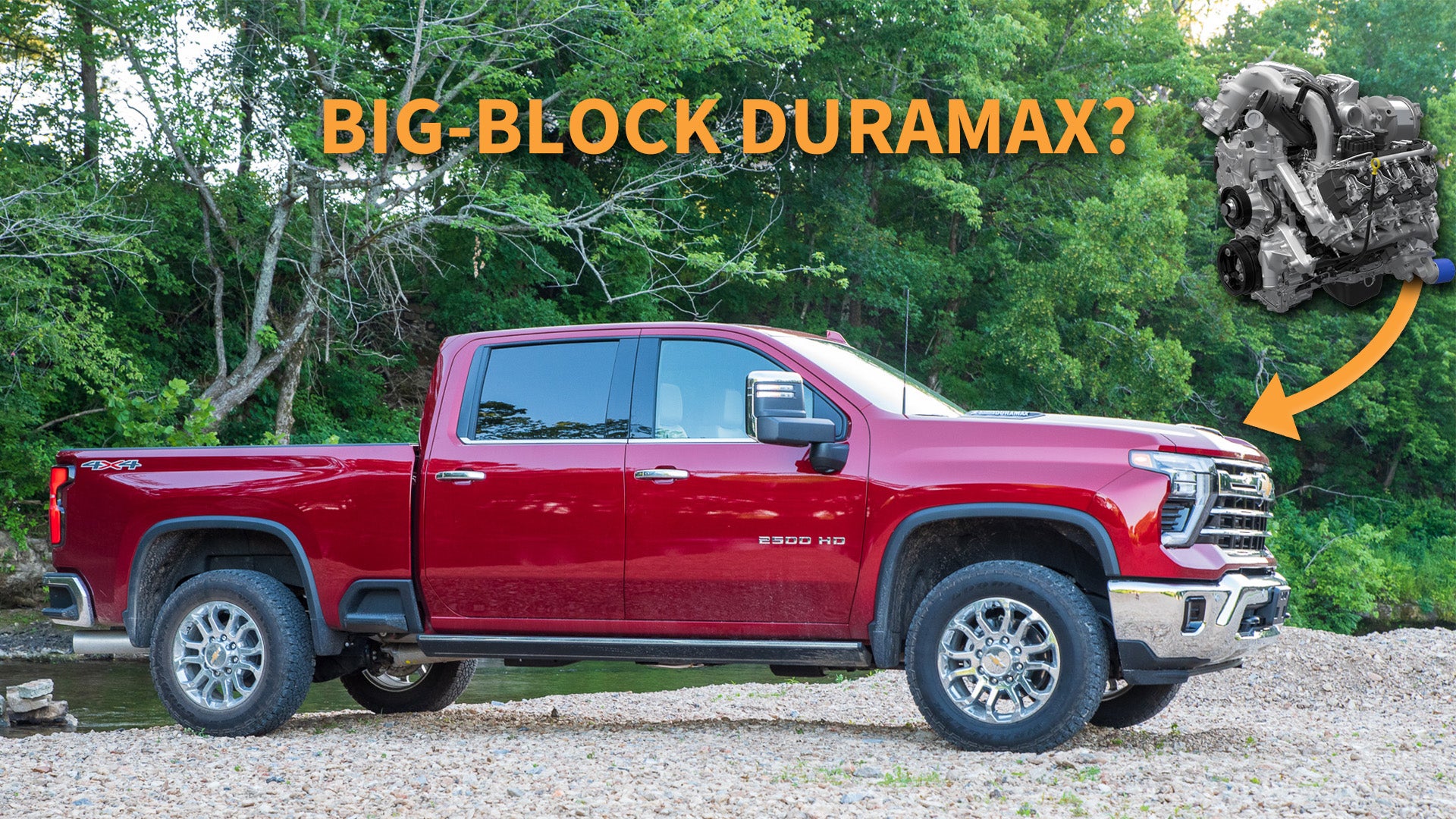Rumored ‘Big-Block’ Duramax Diesel Could Be 8.3L and We’re Off the Rails Now::You’d expect diesel engines to get smaller as time goes on, but recent reports claim GM’s truck power plant could grow by more than a liter.
8.3L is what it takes to haul that fat American ass.
Normally I’d say people who buy these cars are not near EV infrastructure, but I know thats not the case in the US.
California passed a law that new vehicle sales in that state, I think past January 2024, cannot be diesel if the engine is under 7 liters. I wonder if this is Duramax’s response.
20204? Seems to be an appropriate timeline, considering the auto lobby
Ha ha. Fixed the Typo.
Because I don’t have enough oversized idiots blasting their headlights in my eyes. Cool.
Feels like the death throes of the internal combustion engine, the supernova before they die out in common usage.
Or not.
Definitely not. Passenger cars will go EV relatively quickly, but you’re not going to see ICE go away in your lifetime.
Heavy duty trucks, aircraft, ships, etc all use petroleum combustion. That’s not going away any time soon. And as long as that’s still around they’ll still be making diesel.
You’ll end up seeing EV half ton and quarter ton pickups, potentially EV replacing the gas option in 2500+ trucks, but they’re going to have a diesel option for decades.
Quite a few big ships you could already kinda call hybrids, as they use diesel generators to run electric motors. One (slightly dodgy) source claimed 80% of worlds cargo ships, but it sounds just a bit too good to be true. But be the number whatever, each one could make use of solar, wind, or batteries to augment or even replace diesel. Or switch to something a bit better, like LNG in the meantime.
The specs for the Tesla Semi are also actually rather impressive, so who knows where that tech leads to in a decade or two.
Air is where they’ll stay the longest, as batteries are simply way too heavy. Unless we invent some magical weightless battery made out of fluff and unicorn farts, there’s very little chance of a viable electric passenger jet especially because unlike fuel which you use up, batteries are just as heavy when you land than when you started.
a couple of notes: those cargo ships (the ones built after @1995ish) almost all use bunker oil or fuel oil to drive electric turbines, generating more torque and smoother power bands than traditionally driven props directly off diesel engines. it’s still burning the worst of the worst in vast quantities, so it’s a marginal upgrade at best, and one that only counts for the newer 30 years of production.
re: semi trucks - apparently there are some drivers who LOVE them and won’t consider returning to ICE, but I imagine they’re edge cases still. https://axleaddict.com/news/truck-driver-loves-teslas-semi-trucks
Sadly yeah. But those turbines could run on almost anything, fuel oil is used simply because it’s the cheapest and there are no laws (or very few) saying they can’t. At least they capped the sulfur content rather hard a few years back, so there is some progress.
And it is a situation that could be fixed with legislation and money if there was a will to do so as the tech already mostly exists, and it wouldn’t even necessarily require huge changes on the ships.
Most if not all freight locomotives are diesel electric as well.
You’re just not going to beat the energy density of diesel. 1 gallon of diesel fuel has roughly 40kwh worth of energy in it. Modern diesel motors are around 35% efficient.
So you’re looking at ~14kwh of useable energy from 1 gallon of diesel, weighing 7 pounds. So 1kwh is around 0.5lbs.
1kwh of EV battery currently weighs ~13-14lbs based on the model 3s battery capacity and weight as well as the Hummer EV.
So on a train or truck with a 5,000gal tank (just using the AC600X locomotive as an example), you’re talking 35,000lbs of carried fuel and 70,000kWh of useable energy.
To carry the same energy, you would need 910,000-980,000lbs of batteries. Twice the weight of the locomotive itself. Even if we increase the density by a factor of 10, you still need almost 3x the weight of batteries as you do diesel.
And the time to charge a 70MWh battery would be insanely prohibitive. Like a few days each time. With a 1MW charger you’re looking at minimum 70 hours if you could run at peak power with no losses. Realistically more like 80 hours with how chargers slow down as the battery gets full and charging losses.
Natural gas could used to be a little bit cleaner, but CNG vehicles use 12-15% more fuel to get the same power than diesels so it would really be a wash on CO2 emissions. And you would have to replace every diesel engine out there along with all the infrastructure just for a less efficient power source. Natural gas is phenomenal for large scale power plants, not as much for ICE vehicles.
It’s the same issue with large ships. You just can’t beat the energy density of petroleum. And ships use the nastiest byproducts of oil refining already because they’re so cheap. Banning using bunker fuel would just cause them to switch to diesel for a little more rather than go full EV. Going back to sail boats is going to happen before EV boats lol.
Same with planes. Batteries are just too heavy for aircraft in any large capacity. Plus it’s not like we really want a bunch of giant flying lithium bombs overhead. Putting out an EV fire is already insanely difficult. Imagine trying to put out the fire from a battery 10x larger that crashed in the woods somewhere.
Diesel isn’t going anywhere any time soon. I would imagine we start producing more biodiesel before the really heavy machinery goes full electric. And as long as there is diesel in use, it’s gonna make its way to consumers in large pickups because diesel can’t just sit around forever and companies are gonna do whatever they can to keep production high to make money.
At least with the locomotive example, you could make it fully electric and hook it up to the grid vs trying to haul around the electricity itself. Would require a good amount of retrofitting to work with existing rail lines, but would be a hell of a lot easier than alternatives to get ICE out of railway power.
For a freight train you absolutely couldn’t. Even high power lines aren’t powerful enough to power the electric motors on a locomotive through the standard way that things like light rails operate.
That locomotive example I used has a 4.5MW electric motor output. It would be next to impossible to get 4.5MW from the line to the motor using a third rail or something. The power draw would be too great for a freight train with say 6 locomotives. I live 50 feet from a rail line and 6 locomotives is about the average I see per train.
And just for scale, there are over 26,000 Class I locomotives like that in service. If each one ran for only 12 hours per day on average, that would eat up half a trillion kWh of power per year. That would be 12% of the total US electricity production per year, assuming no losses in transmission or efficiency.
You certainly can run freight trains off of electrified tracks. E.g. the iron ore trains in Scandinavia, which go up to 8500 tons, using a pair of locomotives that together output 10 MW https://sv.wikipedia.org/wiki/Malmbanan https://en.wikipedia.org/wiki/Iore
The US is running longer and longer trains as you have observed (up to a max of 14,000 tons), but that is only because they keep fucking over their staff so they quit, so they have to do that out of necessity due to a lack of drivers. It’s far more dangerous as it increases the risk of derailment, it means the trains can’t fit in sidings (which screws over scheduling as trains can’t pass each other) and ought to be stopped.
It would be next to impossible to get 4.5MW from the line to the motor using a third rail or something.
Most modern electric locos and EMUs are 6 MW and up on European 15 or 25 kV AC systems. 8-9 MW is very typical for higher end locos and the BR412 EMU in its longest configuration (for an example of the maximum I can think of) can pull 11.55 MW temporarily, and all of that is from one pantograph. Doing cargo with electric locos is only impossible in NA because… well, because you can’t, because there is no elecrification. Every single corner to has been cut to save every imaginable cost. It’s not like you could try and see what’s better, you literally only have old-school diesel tech.
Part of the trouble with alternative energy sources is that ICE engines, and their liquid hydrocarbon fuels, are really very good at both energy density and power output. Trying to power a ship like that on just solar panels would be completely impractical, even if the entire ship had a solid roof of solar panels above it. It just wouldn’t have enough power. For energy storage, batteries won’t help much. Between their weight and their lower energy density compared to liquid fuels, it just wouldn’t be possible to power the whole ship with Lithium ion Batteries. And that’s even before concerns about seawater, corrosion, or thermal runaway are taken into account. Wind would not mean powering generators, so much as it would just be a return to effectively sailing ships, even if it’s done with a more efficient airfoil type sail.
The long and short of it is, we’re really a very long way from replacing the power source of things like cargo ships and aircraft. This is where things like alternative liquid fuels can be valuable. There have already been successful experiments in capturing atmospheric carbon and using sunlight (not solar electricity, heat from concentrated sunlight) to drive a reaction that transforms that captured carbon into a diesel-compatible fuel. It will always involve a net loss, as far as an energy source, but the resulting fuel can still work in systems that traditional renewables can’t replace, while being as close to carbon neutral as possible.
You’re right, I should have specified “consumer ICE.”
It’ll become rarer, but will never go away. As long as diesel is being made, heavier duty trucks will have a diesel option.
Even if it becomes a solely biodiesel option. You’re just not going to beat the efficiency, energy density, and quick refueling of an internal combustion engine until you can have a battery 1/15 the mass for the same energy, and can charge the thing in under half an hour, and doesn’t cost more than the vehicle itself when it’s time to replace it.
ICE engines, and diesels in particular can run for millions of miles. The record for a semi mileage is just over 3 million miles on the engine. You’re not going to find a battery pack that can go anywhere remotely close to that long. Especially in a heavy use vehicle like a truck that will be constantly going through charge cycles.
Just looking at the Tesla semi, the 500 mile range battery is 900kWh. A 100kWh model S battery costs $15,000 to replace, with $13,500 of that being the battery itself. Scaled up, the semi battery would be in the $90-100k range to replace.
The average semi runs around 100,000 miles per year. If you can get 1,000 full charge cycles out of the battery, you’d be replacing one every 5 years to the tune of nearly $100k each time. Not to mention replacing the electric motors themselves at several grand pop, and those don’t tend to last as long as the battery. Especially in a truck hauling 82,000lbs.
I agree. The energy density is simply too good to best with anything on the horizon.
Aircraft and long haul trucking, especially.
Why are we celebrating this?
If you read the article, you would see that larger diesel engines have lower emissions due to reduced compression ratios.
So big vehicles are good now. Can’t wait for cigarettes to get good again.
An engine increasing in size by 1 liter does not make the vehicle itself larger. These vehicles exist, that is not changing. Manufacturers are working to make these engines more efficient.
If you read the article, you would see thatif you believe the entirely baseless claim in that article, …
There you go.
If you don’t understand mechanical engineering and take your own knowledge of engines as being better than the calculations of literal engineers…
Damn I could’ve sworn I’ve studied that for 6 years and am an actual mechanical engineer! To be fair I’m not working in automotive anymore but I have trained as an automotive mechatronic before majoring ME.
I’m also wondering what calculations I’m supposed to doubt here, it’s literally a rumoured engine, no specs other than a displacement that could(!) be 8.3L, no emission data, to performance data. I’m just calling out that author’s claim that they made it bigger so it has less emissions. It’s obvious marketing bullshit he’s parroting. They were forced to, among other things, reduce compression due to emission laws and the resulting engine is inevitably less efficient, so they (could!) made it bigger to negate the efficiency losses and still be able to have a new model with more horsepower than the last one, despite having a less efficient ICE, obviously at the cost of fuel economy and all other emissions but nitrogen oxides. Not that it matters to their customers but that’s what it is, and only a marketing department could come up and twist this into something positive they have thought of to tackle emissions. And stop it with this engineers’ calculations bs, this shit isn’t even technical. NOx formation is far more complicated than just being a function of compression, it’s affected by how hot a mixture burns, determined by how gradual and geometrically even the combustion takes place and how much volume of the chamber is utilised or whether it concentrated to a specific region. Cylinder head geometry and injector design and actuation play just as big a role as compression (which really is a beneficial side effect to modern injector design that lead to a more efficient combustion.) They could’ve just reverted all that lean-burn technology (obviously not lean-burn for a Diesel but it’s the same philosophy) and sold the car with slightly less NOx emissions, but that’s not what this is about. It’s about marketing not being happy about an engine with less horsepower, so they let them build it with more displacement and made up a story of how they made it bigger so it could emit less NOx. They know dense people will buy that.
Are we celebrating this? Looks more like just reporting on it to me…
They’ll never get smaller because emissions laws would affect them more.
Holy shit I thought the 6.6 in my 2500 was huge, but imagine how much the block would weigh on an 8.3L. I mean at some point your front suspension gets absolutely crazy. Would be smart if they could make it a straight six though instead of a V8, way better balance characteristics and that’s why many of the big diesels have that layout.
Packaging, that’s a big V8 already to fit under the hood. Tracktor trailers have big big long hoods
I know they’ve gotten more compact, but the 8.3L in our L8000 with it’s transmission probably weighs as much as my F350.
Nice to see the burgerland folks adopting metric units like liter









